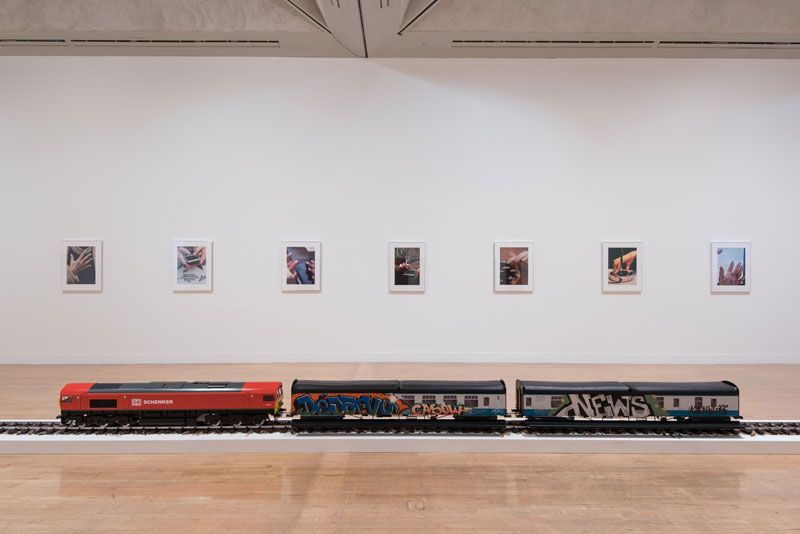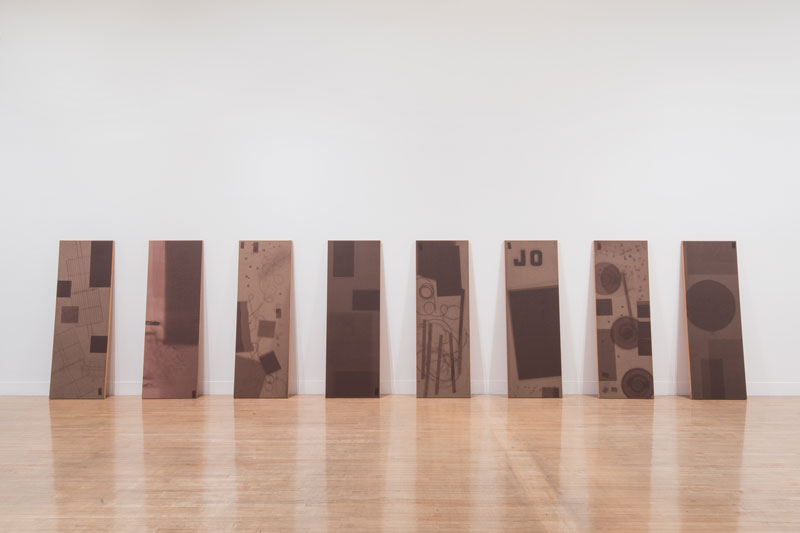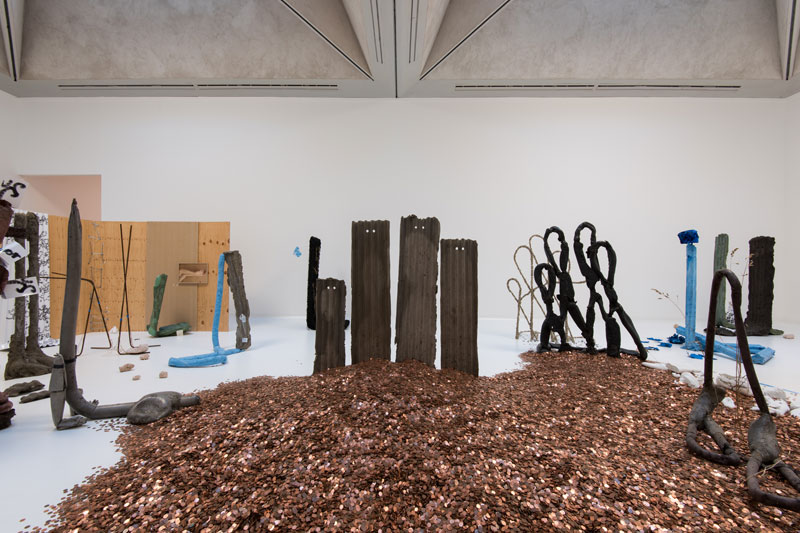Is it really that time of year already? It seems like yesterday that I was waiting in line to board a morning flight up to Glasgow to cover the last incarnation of the Turner Prize. This year’s Turner Prize sounds exciting on paper. Visit and you’ll see a pair of Brobdingnagian hands groping an appropriately scaled pair of buttocks; a jumble of sinister Heath Robinson contraptions that may or may not be the ruins of our civilisation, a graffiti-strewn Deutsche Bahn train held up by leaves on the track and, should you ever have wondered, what £20,000 looks like when broken down into pennies. Sounds fun, no?
The reality is rather less stimulating, but – for reasons I’ll return to – this is not entirely the fault of the artists themselves. The opening gallery features a showcase for the hotly tipped Helen Marten, whose work I’ve never entirely got along with. Perhaps it’s the surfeit of hype that has surrounded her career to date, but though her ideas are often fascinating, they rarely translate into a proportionally arresting result.
Helen Marten’s installation at the ‘Turner Prize 2016’, Tate Britain. Courtesy Joe Humphrys © Tate Photography

The same is pretty much true of her room here. The Tate’s wall text suggests that Marten wants us to enter her showcase thinking of ourselves as ‘archaeologists of our own times […] to consider objects as if seeing them for the first time’. For whatever reason, it is split into three sections, in each of which is arranged a jumble of assemblages strung together from household objects and bits of machinery. Hard as I tried to defamiliarise myself with the constituent parts of the collected detritus, I couldn’t really suspend my disbelief.
In one, a croissant shaped sculpture dangles from a shelf, limp as an animal carcass. That it was pieced together from what appear to be kitchen implements and sections of pipe gave me no particular revelation. In another, a pair of mannequin’s legs sprawl across a wooden frame that looks like something IKEA might manufacture were its customers in the market for medieval torture instruments. All this might add up to something were it exhibited differently: the Tate’s standard issue white walls and polished floorboards render it all rather inert.
Anthea Hamilton’s installation at the ‘Turner Prize 2016’, Tate Britain. Courtesy Joe Humphrys © Tate Photography

Anthea Hamilton’s room, divided into two sections, is a different kettle of fish entirely. You leave Marten’s puzzling display and – bam! – you’re face to cheek with those buttocks. The derriere in question – an invitation for a one word review if ever there was one – is infinitely more imposing in the proverbial flesh than the widely circulated press images would suggest. Carved onsite from polystyrene, it is based on architect Gaetano Pesce’s unrealised project for a doorway to a Manhattan apartment block. The cartoonish definition only adds to the sense that you’re trapped in an R. Crumb strip.
Such is the shock of finding yourself standing directly underneath this rectal monolith, it takes a while to register that the gallery walls are clad in imitation brick wallpaper, and that a suit in the same pattern is dangling from the ceiling. Beyond the bum that separates the space, Hamilton has got a team of set decorators to do up the walls as a trompe l’oeil blue sky, dotted with comically fluffy clouds. Apparently, it is supposed to evoke the London sky at 3pm on a sunny day in June. I’ll take her word for it. Across this side of the room is strung a washing line from which hang five chastity belts into which art nouveau patterns by Hector Guimard are cut. Why? Let’s not go there.
That all this is backed up by critical theory as dense as osmium shouldn’t put you off. Hamilton’s surrealist maximalism is immersive and ambitious enough to work on its own terms – and for my money, she provides the only really successful display here.
Josephine Pryde’s installation at the ‘Turner Prize 2016’, Tate Britain. Courtesy Joe Humphrys © Tate Photography

Josephine Pryde’s showing is a confusing proposition. One wall presents a dozen or so glossy photos of manicured hands fondling smartphones, apparently intended to ‘draw our attention to the point at which the body and the object meet’.
Without prompting any particular interest, they reminded me of Christopher Williams’s ‘For Example’ series, and suffered by comparison. Across the centre of the gallery, that replica train I mentioned lies stopped in its tracks. Every time Pryde exhibits it in a new city, a local graffiti artist is invited to tag it: a neat calling card, but a cattle class work of art.
Much better is a set of kitchen surfaces that Pryde covered in random objects and left exposed to sunlight. The boxy impressions left by her detritus resemble botched early attempts at x-rays, and hark back to Robert Rauschenberg, the undisputed master of this sort of thing. This time, the comparison is not entirely unflattering.
Josephine Pryde’s installation at the ‘Turner Prize 2016’, Tate Britain. Courtesy Joe Humphrys © Tate Photography

A set of stickers bearing nonsense phrases plaster the doorway into Michael Dean’s intriguing display, which in terms of both politics and genesis (his work is based solidly in a very Keith Arnatt reading of language) seems like a contemporary revisitation of 1970s conceptual art.
Dean’s room features a white lino floor, which makes you feel for all the world like you’ve wandered into Pingu’s winter wonderland. Indeed, the Phyllida Barlow-ish sculptural totems plonked haphazardly round the gallery have a gawky bearing not dissimilar from that show’s plasticine penguins.
These sculptures are accessories to the room’s central exhibit, for which Dean borrowed £20,436 (the exact sum the UK government stipulates as its official poverty line), converted it into pennies and dumped it in the middle of the gallery. He then removed a single coin, plunging his ‘family’ of awkward sculptures into state defined penury. You have to tiptoe around Dean’s money to negotiate the room. I can’t help but suspect that in a bluntly metaphorical way, this is the point. Subtle it ain’t, but however derivative it sounds, Dean’s display sticks in the mind.
Michael Dean’s installation at the ‘Turner Prize 2016’, Tate Britain. Courtesy Joe Humphrys © Tate Photography

So, a mixed bag but a worthwhile one. My principal complaint, in fact, has nothing to do with the art itself. What really rankles is the Tate’s presentation of the show. When the Turner exhibition leaves London every other year, it becomes the event it should be. Here, it feels dwarfed by goings on elsewhere in the museum, like an embarrassing adjunct to Pablo Bronstein’s Duveen Gallery commission.
After the notoriety it attracted in the 1990s (which, lest we forget, introduced contemporary art to a wholly new audience in this country), the Tate is keen to present the Turner Prize as a serious affair. But devoid of shock value, an earnest showcase of British contemporary art simply can’t hold its own here anymore. Perhaps it’s finally time for the mothership to cut loose.
The Turner Prize 2016 is at Tate Britain until 2 January 2017.



